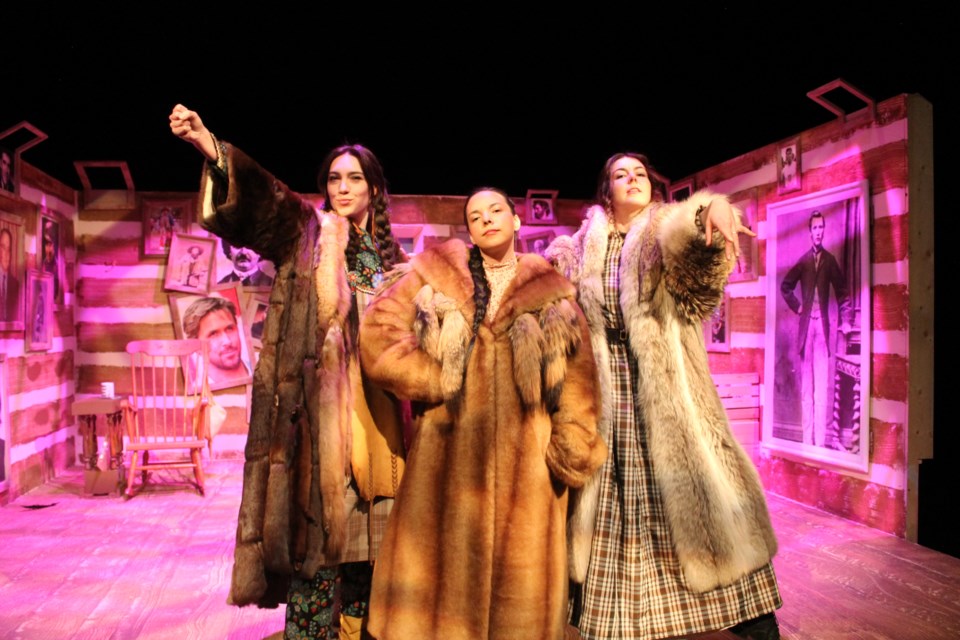“Know what isn’t cool Thomas? Genocide.”
Magnus Theatre has found a wonderful end-cap to their best season since COVID.
Frances Koncan’s Woman of the Fur Trade is a wild, witty ride through a chapter of Canadian history you’ve probably never seen told like this before. Set during the Red River Resistance, the play follows three women- each with wildly different political opinions, romantic aspirations, and senses of humour as they navigate life in a colonial world that's literally and figuratively under siege.
The play mixes historical fact with sharp satire and a totally modern sensibility. There are nods to pop culture and fourth-wall breaks galore, but none of it feels forced. Instead, it gives the play an infectious energy and helps connect the dots between past and present, especially when it comes to colonialism, gender roles, and who gets to write history.
Co-directed by Amy Sellors and Richard Comeau — the show is clever, timely, and totally refreshing. If you're into theatre that plays with form and perspective while still delivering genuine laughs and insights, this one's for you.
The cast delivered strong, engaging performances throughout this dialogue-heavy production. It’s not an easy play to pull off, given how much of it hinges on quick wit, precise timing, and emotional undercurrents bubbling just beneath the surface, but the ensemble rose to the challenge.
What was particularly impressive was how well the cast handled the unexpected. Partway through the performance, a rather unfortunate hair and wardrobe mishap occurred, but instead of derailing the scene, the actors leaned into it. They stayed completely in character, and the moment was so seamlessly woven into the action that it felt almost intentional.
While the entire cast brought energy and heart to the production, a few performances truly stood out, particularly from the three female leads.
Jaimie Henderson brought a real emotional complexity to the role of Cecilia, the wife of a fur tradesman who finds herself torn between duty, love, and a growing sense of self. Henderson’s performance was deeply human and very funny. She portrayed Cecilia’s internal conflict perfectly, allowing us to feel the tension between her comfort of familiarity and the call for something more. Her comedic timing- especially in scenes where her emotions boiled over, added a charming layer of contradiction that felt incredibly relatable.
Lisa Nasson lit up the stage as Marie-Angelique, a Métis woman swept up in her admiration and romantic obsession for Louis Riel. Nasson leaned fully into the play’s satirical tone, delivering her lines with a wink and a fire that made Marie-Angelique’s idealism feel both funny and poignant. There was an infectious energy to her performance, and her ability to shift from comedic to sincere in a heartbeat gave her character surprising emotional depth.
Grace Lamarche gave a standout performance as Eugenia, a First Nations woman whose sharp wit and clarity of purpose made her the emotional anchor of the trio. Lamarche played Eugenia with intelligence, confidence, and a kind of weary pragmatism that cut through the chaos around her. Her concern for the future of her people was palpable in every scene, and she delivered some of the play’s most powerful moments perfectly alongside her other leads.
“It’s funny, it tells such a great Indigenous story and it celebrates Canadian history,” said Lamarche on why people should come see the show.
The set was genuinely impressive, a smart, thoughtful design that added a lot to the storytelling without ever trying to steal the spotlight.
Joe Pagnan’s work here is a real testament to their skill. They created a space that immediately gave us the sense that these characters were boxed in- physically, emotionally, and historically. The walls felt close, the environment a little too tight, which really played into the themes of confinement and resistance that run through the play.
What stood out even more was how fluidly the set transformed. Pagnan clearly understands how to use a space like Magnus Theatre’s stage to its full potential. The design gave the actors room to play and the story room to breathe, all while staying rooted in the world of the play.
Smart, effective, and really well executed, the set was beautifully brought to life by Anika Binding’s lighting design, which really pulled everything together. Her use of both dramatic lighting effects and practical sources like firelight added so much texture to the space. Binding’s work paired so well with Joe Pagnan’s set that the two designs felt like they were in constant conversation.
Overall Women of the Fur Trade is one of the best shows put on by Magnus in recent history and everyone involved should be very proud of their work. I highly recommend seeing it.
9/10
